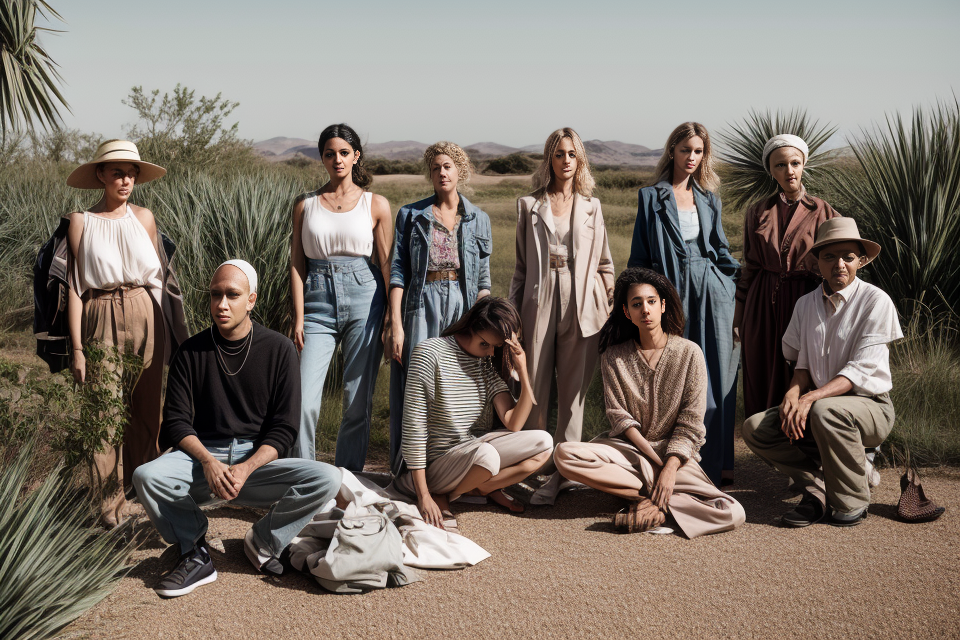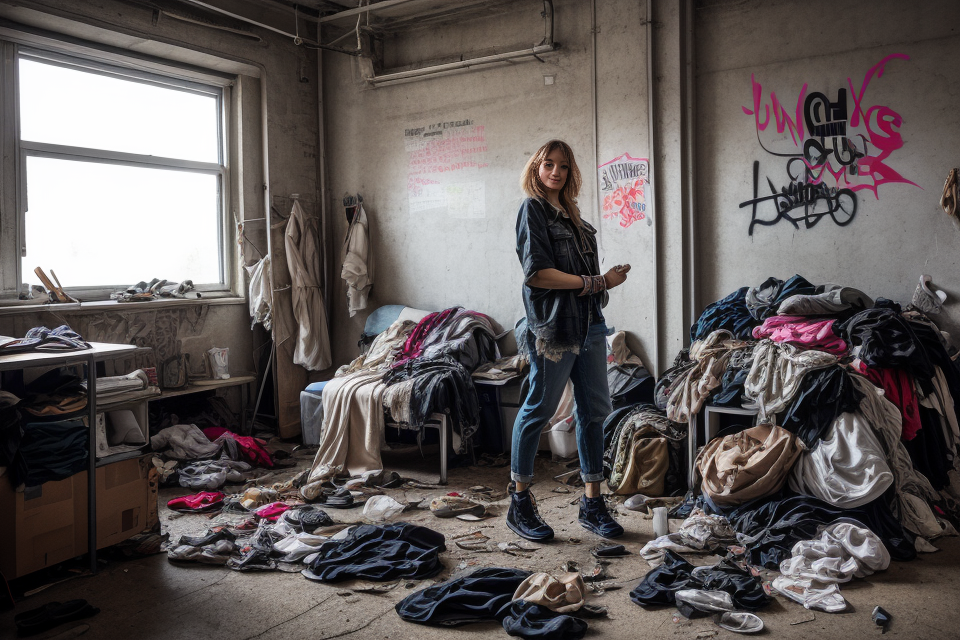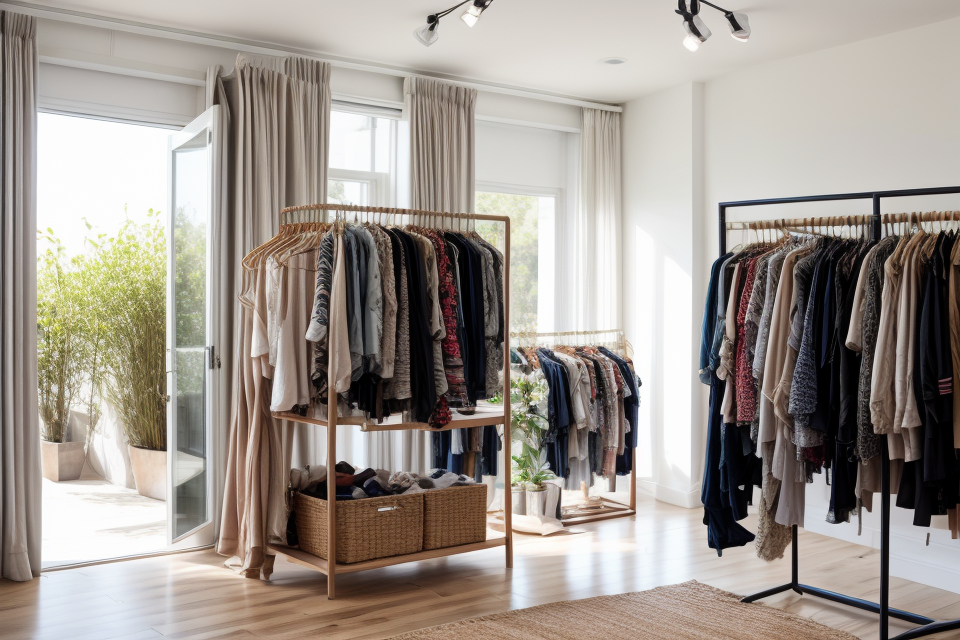
The sustainable fashion movement has gained momentum in recent years, with more and more people becoming aware of the environmental and social impact of the fashion industry. But who started this movement? The origins of sustainable fashion can be traced back to the 1960s and 1970s, when a small group of designers and activists began advocating for more eco-friendly and ethical practices in the fashion industry. These pioneers were ahead of their time, and their work laid the foundation for the sustainable fashion movement as we know it today. In this article, we will explore the history of sustainable fashion and the people who started it all. From early eco-fashion designers to modern-day sustainability activists, we will take a look at the key figures who have shaped the sustainable fashion movement. So, let’s dive in and discover the rich history of sustainable fashion and the people who made it happen.
The Emergence of Sustainable Fashion
Early Pioneers of Sustainable Fashion
Eva Kruse
Eva Kruse, a Danish fashion industry professional, played a significant role in the emergence of sustainable fashion. She founded the Global Fashion Agenda, an organization dedicated to promoting sustainability in the fashion industry. Through her work, Kruse has helped raise awareness about the environmental and social impact of fashion, and has advocated for sustainable practices across the industry.
Stella McCartney
Stella McCartney, a British fashion designer, is often credited with being one of the pioneers of sustainable fashion. She has been vocal about her commitment to sustainability and has made it a central part of her brand. McCartney’s designs are characterized by their eco-friendly materials and ethical production methods, and she has been a leading voice in the movement to promote sustainable fashion.
Levi’s
Levi’s, one of the world’s most iconic denim brands, has also been at the forefront of the sustainable fashion movement. The company has been working to reduce its environmental impact through initiatives such as water-saving techniques and the use of sustainable materials. Levi’s has also been a leader in promoting fair labor practices and worker rights, ensuring that its products are made under safe and ethical conditions.
Key Events in the History of Sustainable Fashion
- The 1992 Earth Summit
- The United Nations Conference on Environment and Development, held in Rio de Janeiro, Brazil, was a pivotal moment in the history of sustainable fashion. The conference brought together leaders from around the world to discuss environmental issues and set global agendas for sustainable development.
- The fashion industry was not initially part of the conference’s agenda, but as awareness of its environmental impact grew, so did the need for more sustainable practices within the industry.
- The 2007 Copenhagen Fashion Summit
- The Copenhagen Fashion Summit, organized by the Danish Fashion Institute, was a milestone event in the sustainable fashion movement. The summit brought together key stakeholders from the fashion industry, including designers, manufacturers, retailers, and policymakers, to discuss sustainable practices and solutions for reducing the industry’s environmental impact.
- The summit led to the development of the Copenhagen Fashion Declaration, which outlined a set of principles for sustainable fashion and encouraged companies to take action towards more sustainable practices.
- The Launch of the Ellen MacArthur Foundation’s “Make Fashion Circular” Initiative
- The Ellen MacArthur Foundation, a UK-based think tank, launched the “Make Fashion Circular” initiative in 2019, which aimed to promote a more circular and sustainable fashion industry.
- The initiative emphasized the need for a circular fashion system, where materials are kept in use for as long as possible, and waste is minimized. It encouraged collaboration between different stakeholders in the industry to develop new technologies and practices that would help achieve this goal.
- The initiative has since gained support from major fashion brands and organizations, and has helped raise awareness of the need for a more sustainable fashion industry.
The Growth of Sustainable Fashion
Consumer Awareness and Demand
The growth of sustainable fashion can be attributed to the changing mindset of consumers. As awareness about the environmental and social impact of the fashion industry has increased, so has the demand for sustainable fashion.
- The Shift in Consumer Mindset
Consumers are becoming more conscious of the environmental and social impact of their purchasing decisions. This shift in mindset has led to a growing demand for sustainable fashion. - The Influence of Social Media
Social media has played a significant role in raising awareness about sustainable fashion. Influencers, fashion bloggers, and brands have used social media platforms to share information about sustainable fashion and promote eco-friendly practices. - The Impact of Influencers
Influencers have played a critical role in shaping consumer attitudes towards sustainable fashion. By promoting sustainable brands and sharing tips for sustainable living, influencers have helped to normalize sustainable fashion and encourage consumers to make more eco-friendly choices.
Industry Response and Progress
- Sustainable Fashion Brands Making Waves
As the sustainable fashion movement gained momentum, a number of innovative brands emerged, leading the charge in the industry. Companies such as Eileen Fisher, Patagonia, and The North Face, were among the pioneers, advocating for sustainable practices and promoting environmentally-friendly products. These brands not only focused on reducing their own environmental impact, but also encouraged their customers to adopt more sustainable lifestyles.
- Collaborations and Partnerships
Collaborations and partnerships have played a crucial role in driving progress in the sustainable fashion industry. In recent years, major fashion brands have teamed up with organizations and initiatives dedicated to sustainability. For example, H&M joined forces with the Global Recycling Day to promote the recycling of textiles, while Levi’s partnered with the Cradle to Cradle organization to develop more sustainable denim products. These collaborations have helped to raise awareness and encourage industry-wide change.
- Sustainable Fashion Certifications and Standards
In an effort to establish clear standards and guidelines for sustainable fashion, a number of certifications and standards have emerged. The Fair Trade USA, for instance, certifies products that meet strict fair labor standards, while the Organic Content Standard (OCS) ensures that textiles contain a minimum percentage of organic material. Additionally, the Global Organic Textile Standard (GOTS) sets criteria for the entire supply chain, from farming to manufacturing, to ensure the use of organic materials and environmentally-friendly processes. These certifications and standards provide a framework for companies to assess their sustainability efforts and strive for continuous improvement.
The Challenges and Critiques of Sustainable Fashion
Environmental Impact
- The Textile Industry’s Water and Energy Consumption
The textile industry is a significant contributor to the global carbon footprint, accounting for approximately 10% of the world’s carbon emissions. The production of textiles requires vast amounts of water and energy, which contribute to the industry’s overall environmental impact. Cotton, in particular, is a resource-intensive crop that requires large amounts of water to grow, leading to water scarcity in many regions where cotton is grown.
- Microplastics in the Ocean
Microplastics are tiny pieces of plastic that are released into the environment, often through the washing of synthetic clothing. These microplastics then make their way into the ocean, where they can harm marine life and disrupt ecosystems. The fashion industry is a significant contributor to the problem, with an estimated 35% of microplastics in the ocean coming from synthetic clothing.
- Textile Waste and Landfills
The fashion industry also generates a significant amount of waste, with an estimated 92 million tons of textile waste generated each year. Much of this waste ends up in landfills, where it takes hundreds of years to decompose. The fast fashion model, which encourages the production of cheap, disposable clothing, has exacerbated the problem, leading to a culture of overconsumption and waste.
In summary, the environmental impact of the fashion industry is significant and multifaceted, with the textile industry’s water and energy consumption, microplastics in the ocean, and textile waste and landfills all contributing to the problem. The sustainable fashion movement aims to address these issues by promoting more environmentally friendly practices in the fashion industry.
Labor Practices
- Exploitation of Labor in Fast Fashion
- Low wages and poor working conditions
- Overuse of temporary and part-time contracts
- Lack of job security and benefits
- The True Cost of Fashion
- Environmental impact of fashion production
- Social and economic costs of fast fashion
- Need for greater transparency in supply chains
- Living Wage and Worker Rights
- Fair compensation for garment workers
- Protection of workers’ rights and safety
- Empowerment of labor unions and collective bargaining
Exploitation of Labor in Fast Fashion
Fast fashion’s business model heavily relies on low-cost production, often resulting in the exploitation of labor. This includes the use of low wages and poor working conditions, as well as the overuse of temporary and part-time contracts that lack job security and benefits. These practices have been widely criticized for their negative impact on garment workers and their families.
The True Cost of Fashion
The true cost of fashion encompasses not only the environmental impact of fashion production but also the social and economic costs associated with fast fashion. This includes the overconsumption of resources, waste generation, and pollution. Furthermore, fast fashion’s rapid production cycle and business model contribute to the perpetuation of a “disposable” culture, where garments are produced cheaply and disposed of after a few wears, leading to an unsustainable pattern of consumption. There is a growing need for greater transparency in supply chains to address these issues and promote more sustainable practices.
Living Wage and Worker Rights
A critical aspect of sustainable fashion is ensuring fair compensation for garment workers. This includes paying a living wage that allows workers to support themselves and their families, as well as protecting their rights and safety in the workplace. Empowering labor unions and promoting collective bargaining can help garment workers negotiate better working conditions and secure their rights.
Overall, addressing labor practices is a crucial aspect of the sustainable fashion movement, as it aims to promote ethical and responsible practices throughout the entire supply chain, from production to consumption.
The Future of Sustainable Fashion
The Path to a More Sustainable Future
- The Circular Economy
- A circular economy is an economic system aimed at minimizing waste and making the most of resources. In the context of fashion, this means designing products with durability and recyclability in mind, as well as finding new ways to reuse and recycle materials.
- One example of this is H&M’s Conscious Collection, which is made from sustainable materials and encourages customers to recycle their old clothes.
- Innovations in Materials and Production
- There are many innovative materials and production techniques being developed to make fashion more sustainable. For example, biodegradable materials like organic cotton and tencel are becoming more popular, as are materials made from recycled plastic bottles.
- In addition, new technologies like 3D printing and laser cutting are being used to create more efficient and sustainable production processes.
- The Potential of Sustainable Technologies
- As technology continues to advance, there is great potential for sustainable innovations in the fashion industry. For example, blockchain technology can be used to track the supply chain and ensure that materials are sustainably sourced.
- Additionally, AI can be used to optimize supply chain management and reduce waste. For instance, AI-powered demand forecasting can help fashion brands reduce overproduction and minimize waste.
By focusing on the circular economy, innovations in materials and production, and the potential of sustainable technologies, the fashion industry can work towards a more sustainable future.
The Role of the Consumer
- The Power of Consumer Choice
- Sustainable Fashion Trends to Watch
- Building a Sustainable Wardrobe
As the sustainable fashion movement continues to gain momentum, the role of the consumer becomes increasingly important. Consumer choice plays a crucial role in shaping the future of sustainable fashion. By making conscious decisions about what they buy and wear, consumers can drive demand for more sustainable and ethical products.
One of the key trends to watch in sustainable fashion is the growing demand for transparency. Consumers are increasingly interested in knowing the origins of the products they buy, including the materials used and the conditions under which they were produced. Brands that are transparent about their supply chains and production processes are likely to gain a competitive edge in the market.
Another trend to watch is the shift towards circular fashion. This involves designing products that can be easily repaired, recycled, or upcycled, reducing waste and maximizing the value of materials. Consumers are increasingly interested in buying products that are designed with sustainability in mind, and brands that embrace circular fashion are likely to attract loyal customers.
Building a sustainable wardrobe is also becoming increasingly important for consumers. This involves making conscious choices about what to buy, such as choosing natural and organic materials, and choosing brands that prioritize sustainability and ethical production. Consumers can also extend the life of their clothes by caring for them properly, repairing them when necessary, and repurposing or donating items that they no longer need.
In conclusion, the role of the consumer is crucial in shaping the future of sustainable fashion. By making conscious choices about what they buy and wear, consumers can drive demand for more sustainable and ethical products, and help to create a more sustainable fashion industry overall.
FAQs
1. Who started the sustainable fashion movement?
The sustainable fashion movement can be traced back to various individuals and organizations who have been advocating for sustainable practices in the fashion industry. Some of the earliest pioneers of sustainable fashion include designer Kate Moss, who created her own sustainable fashion line in the 1990s, and environmentalist and author, Annie Leonard, who wrote a book called “The Story of Stuff” in 2010 that highlighted the environmental impact of fast fashion.
2. When did the sustainable fashion movement start?
The sustainable fashion movement has its roots in the 1960s and 1970s, when environmentalism and the anti-Vietnam War movement sparked a desire for more sustainable and ethical practices. However, it wasn’t until the 1990s that sustainable fashion really began to gain traction, with designers like Stella McCartney and Vivienne Westwood leading the way.
3. What was the catalyst for the sustainable fashion movement?
The catalyst for the sustainable fashion movement was a growing awareness of the environmental and social impact of the fashion industry. As consumers became more conscious of the environmental impact of their purchases, they began to demand more sustainable and ethical practices from fashion brands. This led to the development of new technologies and materials, as well as new business models that prioritize sustainability.
4. What is the goal of the sustainable fashion movement?
The goal of the sustainable fashion movement is to create a fashion industry that is more sustainable and ethical. This includes reducing waste and pollution, promoting fair labor practices, and using environmentally friendly materials and processes. The ultimate aim is to create a circular fashion system that minimizes waste and maximizes the use of resources.
5. How has the sustainable fashion movement evolved over time?
The sustainable fashion movement has evolved significantly over time, with new technologies and materials being developed, and new business models emerging. Today, sustainable fashion is no longer a niche market, but a mainstream trend that is driving change in the fashion industry. Many major fashion brands are now incorporating sustainable practices into their operations, and consumers are demanding more transparency and accountability from the companies they buy from.


